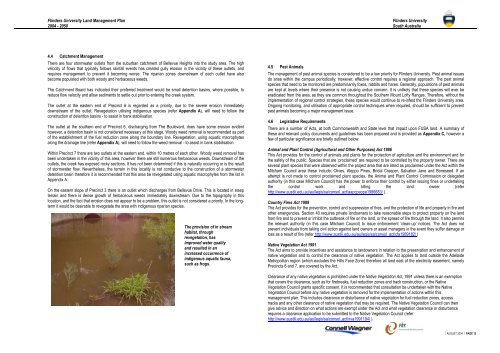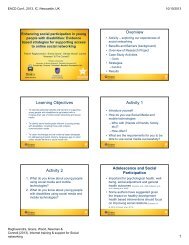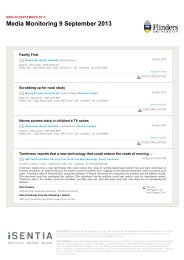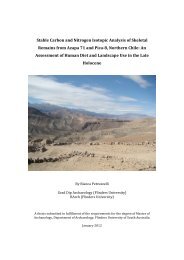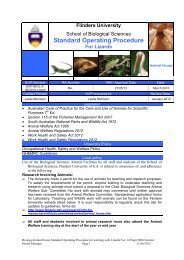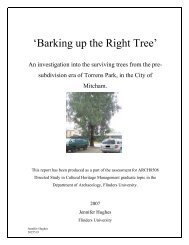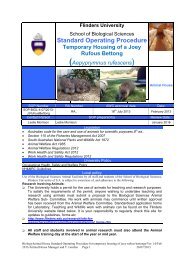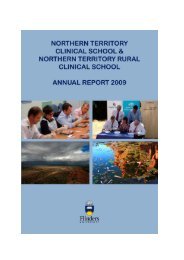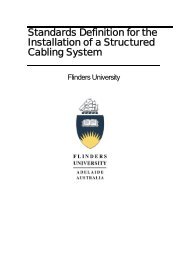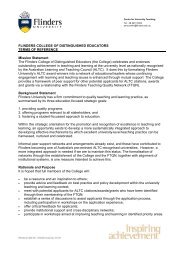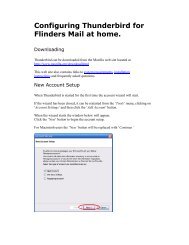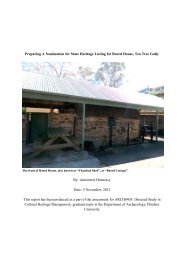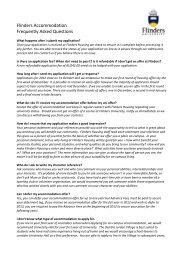Land Management Plan 2004 - 2050 Flinders University South ...
Land Management Plan 2004 - 2050 Flinders University South ...
Land Management Plan 2004 - 2050 Flinders University South ...
You also want an ePaper? Increase the reach of your titles
YUMPU automatically turns print PDFs into web optimized ePapers that Google loves.
<strong>Flinders</strong> <strong>University</strong> <strong>Land</strong> <strong>Management</strong> <strong>Plan</strong> <strong>Flinders</strong> <strong>University</strong><br />
<strong>2004</strong> - <strong>2050</strong> <strong>South</strong> Australia<br />
4.4 Catchment <strong>Management</strong><br />
There are four stormwater outlets from the suburban catchment of Bellevue Heights into the study area. The high<br />
velocity of flows that typically follows rainfall events has created gully erosion in the vicinity of these outlets, and<br />
requires management to prevent it becoming worse. The riparian zones downstream of each outlet have also<br />
become populated with both woody and herbaceous weeds.<br />
The Catchment Board has indicated their preferred treatment would be small detention basins, where possible, to<br />
reduce flow velocity and allow sediments to settle out prior to entering the creek system.<br />
The outlet at the eastern end of Precinct 6 is regarded as a priority, due to the severe erosion immediately<br />
downstream of the outlet. Revegetation utilising indigenous species (refer Appendix A), will need to follow the<br />
construction of detention basins - to assist in bank stabilisation.<br />
The outlet at the southern end of Precinct 6, discharging from The Boulevard, does have some erosion evident<br />
however, a detention basin is not considered necessary at this stage. Woody weed removal is recommended as part<br />
of the establishment of the fuel reduction zone along the boundary line. Revegetation, using aquatic macrophytes<br />
along the drainage line (refer Appendix A), will need to follow the weed removal - to assist in bank stabilisation.<br />
Within Precinct 7 there are two outlets at the eastern end, within 10 metres of each other. Woody weed removal has<br />
been undertaken in the vicinity of this area, however there are still numerous herbaceous weeds. Downstream of the<br />
outlets, the creek has exposed rocky sections. It has not been determined if this is naturally occurring or is the result<br />
of stormwater flow. Nevertheless, the terrain in this locality is not conducive to the construction of a stormwater<br />
detention basin therefore it is recommended that this area be revegetated using aquatic macrophytes from the list in<br />
Appendix A.<br />
On the eastern slope of Precinct 3 there is an outlet which discharges from Bellevue Drive. This is located in steep<br />
terrain and there is dense growth of herbaceous weeds immediately downstream. Due to the topography in this<br />
location, and the fact that erosion does not appear to be a problem, this outlet is not considered a priority. In the longterm<br />
it would be desirable to revegetate the area with indigenous riparian species.<br />
The provision of in stream<br />
habitat, through<br />
revegetation, has<br />
improved water quality<br />
and resulted in an<br />
increased occurrence of<br />
indigenous aquatic fauna,<br />
such as frogs.<br />
4.5 Pest Animals<br />
The management of pest animal species is considered to be a low priority for <strong>Flinders</strong> <strong>University</strong>. Pest animal issues<br />
do arise within the campus periodically; however, effective control requires a regional approach. The pest animal<br />
species that need to be monitored are predominantly foxes, rabbits and hares. Generally, populations of pest animals<br />
are kept at levels where their presence is not causing undue concern. It is unlikely that these species will ever be<br />
eradicated from the area, as they are common throughout the <strong>South</strong>ern Mount Lofty Ranges. Therefore, without the<br />
implementation of regional control strategies, these species would continue to re-infest the <strong>Flinders</strong> <strong>University</strong> area.<br />
Ongoing monitoring, and utilisation of appropriate control techniques when required, should be sufficient to prevent<br />
pest animals becoming a major management issue.<br />
4.6 Legislative Requirements<br />
There are a number of Acts, at both Commonwealth and State level that impact upon FUSA land. A summary of<br />
these and relevant policy documents and guidelines has been prepared and is provided as Appendix C, however a<br />
few of particular significance are briefly outlined below:<br />
Animal and <strong>Plan</strong>t Control (Agricultural and Other Purposes) Act 1986<br />
This Act provides for the control of animals and plants for the protection of agriculture and the environment and for<br />
the safety of the public. Species that are ‘proclaimed’ are required to be controlled by the property owner. There are<br />
several plant species that were observed within the project area that are listed as proclaimed under the Act within the<br />
Mitcham Council area these include; Olives, Aleppo Pines, Bridal Creeper, Salvation Jane and Boneseed. If an<br />
attempt is not made to control proclaimed plant species, the Animal and <strong>Plan</strong>t Control Commission or delegated<br />
authority (in this case Mitcham Council) has the power to enforce their control by either issuing fines or undertaking<br />
the control work and billing the land owner (refer<br />
http://www.austlii.edu.au/au/legis/sa/consol_act/aapcpaopa1986683/ ).<br />
Country Fires Act 1989<br />
The Act provides for the prevention, control and suppression of fires, and the protection of life and property in fire and<br />
other emergencies. Section 40 requires private landowners to take reasonable steps to protect property on the land<br />
from fire and to prevent or inhibit the outbreak of fire on the land, or the spread of fire through the land. It also permits<br />
the relevant authority (in this case Mitcham Council) to issue enforcement ‘clean-up’ notices. The Act does not<br />
prevent individuals from taking civil action against land owners or asset managers in the event they suffer damage or<br />
loss as a result of fire (refer http://www.austlii.edu.au/au/legis/sa/consol_act/cfa1989182/ )<br />
Native Vegetation Act 1991<br />
The Act aims to provide incentives and assistance to landowners in relation to the preservation and enhancement of<br />
native vegetation and to control the clearance of native vegetation. The Act applies to land outside the Adelaide<br />
Metropolitan region (which excludes the Hills Face Zone) therefore all land east of the electricity easement, namely<br />
Precincts 6 and 7, are covered by the Act.<br />
Clearance of any native vegetation is prohibited under the Native Vegetation Act, 1991 unless there is an exemption<br />
that covers the clearance, such as for firebreaks, fuel reduction zones and track construction, or the Native<br />
Vegetation Council grants specific consent. It is recommended that consultation be undertaken with the Native<br />
Vegetation Council before any native vegetation is removed for the implementation of actions within this<br />
management plan. This includes clearance or disturbance of native vegetation for fuel reduction zones, access<br />
tracks and any other clearance of native vegetation that may be required. The Native Vegetation Council can then<br />
give advice and direction on what actions are exempt under the Act and what vegetation clearance or disturbance<br />
requires a clearance application to be submitted to the Native Vegetation Council (refer<br />
http://www.austlii.edu.au/au/legis/sa/consol_act/nva1991194/ ).<br />
⏐ AUGUST <strong>2004</strong> ⏐ PAGE 12


